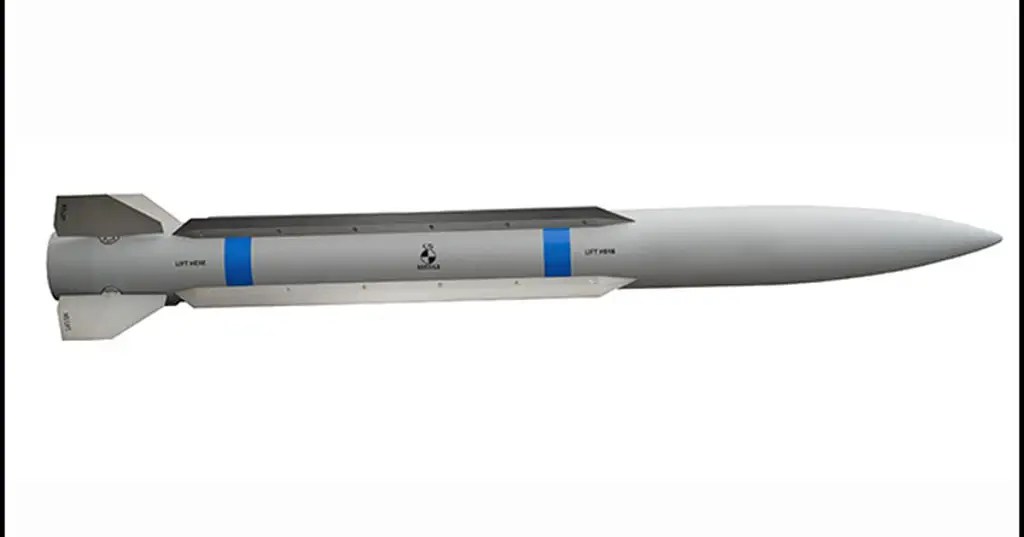Winston
Lorenzo von Matterhorn
- Joined
- Jan 31, 2009
- Messages
- 9,560
- Reaction score
- 1,748
Raytheon's Pint-Sized Peregrine Air-To-Air Missile
The new missile would give fighter jets more magazine depth, which is especially valuable for stealth fighters that carry their weapons internally.
18 Sep 2019
https://www.thedrive.com/the-war-zo...air-missile-the-pentagon-has-been-waiting-for
Raytheon recently unveiled a new medium-range missile design that is roughly half the size of the company's existing AIM-120 Advanced Medium-Range Air-to-Air Missile, or AMRAAM, but that it says will have equivalent and in some cases superior performance. The new weapon, called Peregrine, could effectively double the number of missiles that fighter jets such the F-35 Joint Strike Fighter or F-22 Raptor can carry internally, greatly increasing their magazine capacity when they are in their most stealthy configurations.
The Massachusetts headquartered defense contractor revealed Peregrine publicly for the first time at the Air Force Association's main annual convention outside Washington, D.C., on Sept. 16, 2019. The new missile is presently an internally-funded project and the plan is to offer it as a complement to the AIM-120, as well as the AIM-9X Sidewinder, both of which are Raytheon products, according to Aviation Week.
The company says that Peregrine will have at least as much reach as an AMRAAM and the maneuverability of a Sidewinder, but in a package just six feet long and weighing only 150 pounds. The AIM-120 is around 12 feet in length and tips the scales at around 345 pounds.
"Peregrine will allow U.S. and allied fighter pilots to carry more missiles into battle to maintain air dominance," Dr. Thomas Bussing, the Vice President of Raytheon Advanced Missile Systems, said in a statement. "With its advanced sensor, guidance and propulsion systems packed into a much smaller airframe, this new weapon represents a significant leap forward in air-to-air missile development."
Raytheon has otherwise offered limited details so far about its missile's exact capabilities and features. Mark Noyes, Raytheon Missile Systems Vice President of Business Development and Strategy, told Aviation Week that Peregrine will have a "multi-mode autonomous seeker" and a "new, high-performance propulsion section," but declined to offers specifics.
The guidance system is tri-mode, according to FlightGlobal, but Raytheon would not say what functionalities it has exactly. A combination of the radar homing capabilities of the AIM-120 with the imaging infrared seeker of the AIM-9X would be the most likely options. This would offer an alternative means of finding the target in the event of electronic warfare jamming during the terminal phase of the missile's flight. It similarly could rely on the radar seeker if the target's defensive countermeasures blinded or confused its infrared optics. The third method of operation could be a capability to actively home in on a target's electromagnetic emissions, such as those from its own radar. A data-link, which it will absolutely have, will only add to the missile's range and ability to more easily kill targets at closer ranges. You can read all about how a data-link and lock-on-after-launch capability enhances an air-to-air missile's capabilities dramatically in this previous piece of ours.


The new missile would give fighter jets more magazine depth, which is especially valuable for stealth fighters that carry their weapons internally.
18 Sep 2019
https://www.thedrive.com/the-war-zo...air-missile-the-pentagon-has-been-waiting-for
Raytheon recently unveiled a new medium-range missile design that is roughly half the size of the company's existing AIM-120 Advanced Medium-Range Air-to-Air Missile, or AMRAAM, but that it says will have equivalent and in some cases superior performance. The new weapon, called Peregrine, could effectively double the number of missiles that fighter jets such the F-35 Joint Strike Fighter or F-22 Raptor can carry internally, greatly increasing their magazine capacity when they are in their most stealthy configurations.
The Massachusetts headquartered defense contractor revealed Peregrine publicly for the first time at the Air Force Association's main annual convention outside Washington, D.C., on Sept. 16, 2019. The new missile is presently an internally-funded project and the plan is to offer it as a complement to the AIM-120, as well as the AIM-9X Sidewinder, both of which are Raytheon products, according to Aviation Week.
The company says that Peregrine will have at least as much reach as an AMRAAM and the maneuverability of a Sidewinder, but in a package just six feet long and weighing only 150 pounds. The AIM-120 is around 12 feet in length and tips the scales at around 345 pounds.
"Peregrine will allow U.S. and allied fighter pilots to carry more missiles into battle to maintain air dominance," Dr. Thomas Bussing, the Vice President of Raytheon Advanced Missile Systems, said in a statement. "With its advanced sensor, guidance and propulsion systems packed into a much smaller airframe, this new weapon represents a significant leap forward in air-to-air missile development."
Raytheon has otherwise offered limited details so far about its missile's exact capabilities and features. Mark Noyes, Raytheon Missile Systems Vice President of Business Development and Strategy, told Aviation Week that Peregrine will have a "multi-mode autonomous seeker" and a "new, high-performance propulsion section," but declined to offers specifics.
The guidance system is tri-mode, according to FlightGlobal, but Raytheon would not say what functionalities it has exactly. A combination of the radar homing capabilities of the AIM-120 with the imaging infrared seeker of the AIM-9X would be the most likely options. This would offer an alternative means of finding the target in the event of electronic warfare jamming during the terminal phase of the missile's flight. It similarly could rely on the radar seeker if the target's defensive countermeasures blinded or confused its infrared optics. The third method of operation could be a capability to actively home in on a target's electromagnetic emissions, such as those from its own radar. A data-link, which it will absolutely have, will only add to the missile's range and ability to more easily kill targets at closer ranges. You can read all about how a data-link and lock-on-after-launch capability enhances an air-to-air missile's capabilities dramatically in this previous piece of ours.




